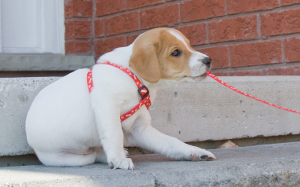Puppy Leash Training - Teach Your Dog How to Walk
 Puppy leash training is a very simple thing to do. People tend to make it much harder than it actually is because they try to fight with their little dog rather than just showing them what they have to do. If you start leash training puppies right from the start, you'll never have to worry about correcting their behavior later on.
Puppy leash training is a very simple thing to do. People tend to make it much harder than it actually is because they try to fight with their little dog rather than just showing them what they have to do. If you start leash training puppies right from the start, you'll never have to worry about correcting their behavior later on. Don't Fight with Your Puppies - Work with Them!
Your puppy wants to follow you wherever you go. You've probably already found that to be true! You can use this to show them the proper way to walk on a leash, and it means you should start leash training as early as possible!
The first thing you need to do though, is make sure that your puppy is comfortable with the leash. Hold it up to them and let them sniff it and even bite at it if they have to. They're just getting a good feel for it.
Once your pup loses interest in the leash, it's a perfect opportunity for you to snap it onto their collar. They might flinch, but that is ok. The first thing you need to do is start walking. Your puppy should follow you, and if they do you should praise them and give them a treat. You want them to associate following you while leashed as a very favorable thing to do!
If your puppy starts to try to do their own thing (and they will, eventually) you need to avoid yanking them. Never yank them hard because you could hurt their neck. You don't want them to be scared to walk on a leash!
When your puppy tries to go their own way, stop walking!
You need to show your little pup right from the start that they won't get anywhere if they try pulling you. This will might make the first couple of walks you go on a little annoying because you won't get far, but it will pay off in spades in the long run! You don't even need to scold your puppy. They will get the message when you refuse to keep walking.
Remember, when your puppy walks alongside you with a loose leash, praise them and pet them and make them feel awesome! You can even give them a treat ever so often.
Here are some more puppy leash training tips:
- Keep in mind that different breeds respond to leashes differently. Some dogs are made to walk, and others are not. For example, if you have a scent hound like a Beagle, for example, you will find that they just follow their noses, and that causes them to pull a lot of the time. It's very difficult to get them to not pull when they pick up an interesting scent, so be patient with them.
- You don't need to use choke chains are barbed collars unless you have a very large, powerful dog that you physically unable to control. If you do have a very big dog that could potentially hurt someone or get into traffic, then a choke chain will help to teach them not to pull, but the same leash training is needed: If they pull, stop walking. This will help them to realize that they need to walk by your side.
- If your puppy is not doing well with their leash training or you are not being consistent in showing them what is expected, you might want to try a harness rather than a collar. Harnesses are better because they don't allow your dog to pull as hard and they can't hurt themselves like they might with a collar around their necks.
Go Back to Puppy Training
Go Back Home to Dog Training